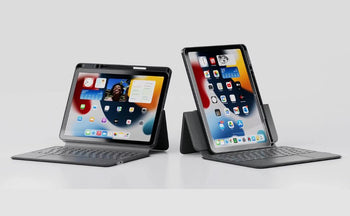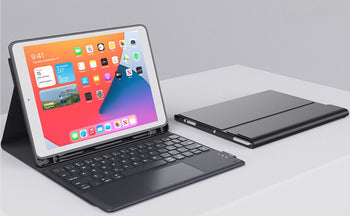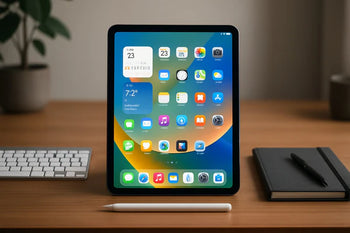If you’ve found yourself asking “Why is my iPad so slow and lagging?”, you’re not alone.
Over time, even Apple’s smooth iPads can start feeling sluggish. Apps may freeze, Safari might crawl, or typing can feel delayed.
The good news is that most slowdowns stem from common causes, such as low storage, outdated software, or heavy background processes.
This guide breaks down every reason your iPad might lag and shows you step-by-step how to speed it up.
Why is my iPad So Slow and Lagging: A Quick Guide
- Check storage and free up at least 1–2 GB. Low space makes iPads crawl.
- Update iPadOS and all apps to the latest versions.
- Restart the device and close apps that freeze.
- Clear Safari data to refresh browsing performance.
- Turn on Reduce Motion and limit Background App Refresh to cut resource use.
- Reset settings if problems persist, or do a clean restore.
- If all else fails, it may be time for Apple Support or a hardware upgrade.
You May Want to Shop
Why Does an iPad Slow Down Over Time?
A sluggish iPad can have many causes, but most are easy to diagnose. Here are the most common reasons:
- Low storage space: When your iPad is nearly full, it slows down because the system needs free room for temporary files.
- Too many open apps: Having several apps running in the background uses memory and processing power.
- Outdated software: Older iPadOS versions can cause lagging, especially if key bugs have not been fixed through updates.
- Aging hardware: Older models might not handle modern app demands as efficiently as newer ones.
- Poor Wi-Fi or network connection: An unstable connection can make web-based apps or downloads sluggish.
- Battery performance issues: When your battery degrades, your iPad may throttle performance to conserve energy.
Now let’s dive into the step-by-step fixes to bring your iPad back to speed.
👉 Also Read: How to Speed Up iPad
Step 1: Check iPad Storage Space

When storage space gets too low, the iPad struggles to run smoothly.
What To Do
- Go to Settings > General > iPad Storage.
- Wait a few seconds for the system to calculate app storage.
- Review the list to see which apps use the most space.
If you notice large apps or games you rarely use, delete them. For essentials, enable Offload Unused Apps to automatically remove unused ones without losing data.
Also, move photos and videos to iCloud Photos or an external drive. Having at least 3 to 5 GB of free space is crucial for optimal performance.
👉 Also Read: How to Get More Storage on iPad (Without Buying a New One)
Step 2: Update Your iPadOS

Apple releases regular updates that include performance optimizations. If your iPad runs an outdated version, it may lag during app use.
How To Update
- Open Settings > General > Software Update.
- Tap Download and Install if a new update is available.
Allow the update to complete with your iPad connected to power and Wi-Fi. After updating, observe whether apps open faster and navigation feels smoother.
Step 3: Restart or Force Restart Your iPad
A simple restart can fix minor software slowdowns by clearing temporary caches.
Normal Restart
- Hold the Power button until “Slide to power off” appears.
- Slide to turn off your iPad.
- Wait 30 seconds, then turn it back on.
Force Restart (If Frozen)
- For iPads with a Home button: Press and hold the Power and Home buttons until the Apple logo appears.
- For iPads without a Home button: Press Volume Up, then Volume Down, then hold Power until restart.
Restarting periodically helps maintain smooth system operation, especially on older models.
👉 Also Read: How to Update iPad: A Guide for the Latest iPadOS
Step 4: Close Apps You’re Not Using
Background apps consume memory (RAM) even when idle.
How To Close Them
- Double-tap the Home button (or swipe up from the bottom on newer models).
- Swipe up on each app preview to close it.
If your iPad feels faster afterward, it means the system memory was overloaded.
👉 Also Read: How to End Apps on iPad: Step-by-Step Methods for All Models
Step 5: Clear Safari Cache and Browsing Data
If Safari lags when loading pages, cached websites may be taking too much space.
How To Clear Safari Cache
- Go to Settings > Safari.
- Tap Clear History and Website Data.
- Confirm your choice.
Restart Safari afterward. This clears old data, making websites load faster.
Step 6: Turn Off Background App Refresh
This feature allows apps to update data in the background, eating into processing and battery resources.
How To Disable
- Open Settings > General > Background App Refresh.
- Tap Off, or choose Wi-Fi only if you still want updates when on a strong network.
Disabling this significantly reduces lag, particularly on mid-range or older iPads.
👉 Also Read: 7 Most Common Apple iPad Problems and How to Fix Them Fast
Step 7: Manage Location and Notifications
Constant background location checks and excessive notifications can slow system response.
What To Do
- Open Settings > Privacy > Location Services.
- Disable location access for non-essential apps.
- Also, go to Settings > Notifications and turn off alerts for lesser-used apps.
This reduces CPU workload and extends battery life at the same time.
Step 8: Turn Off Automatic Downloads
Automatic app, book, and update downloads can cause lag, especially when using the iPad.
How To Manage
- Go to Settings > App Store.
- Switch off Automatic Downloads for apps and updates.
Now updates will only happen when you trigger them, preventing slowdowns during use.
👉 Also Read: Where Do I Find Downloads on My iPad? Easy Guide [2025]
Step 9: Reduce Motion and Transparency
Visual effects like parallax scrolling and background transparency can look nice but also demand processing power.
How To Adjust
- Go to Settings > Accessibility > Motion.
- Enable Reduce Motion.
- Go to Settings > Accessibility > Display & Text Size and turn on Reduce Transparency.
These changes immediately make navigation snappier, especially for older iPads.
Step 10: Check Internet Connection Speed
A slow iPad might not be the device’s fault—it could be your internet connection.
How To Verify
- Open a speed test site such as Speedtest.net.
- If speeds are low, restart your Wi-Fi router.
- Try switching between 2.4GHz and 5GHz Wi-Fi bands for better consistency.
- If possible, move closer to the router to boost signal stability.
If you only notice lag during online streaming or gaming, improving Wi-Fi connection can solve the problem.
Step 11: Reset All Settings Without Losing Data
When regular fixes don’t work, resetting all system settings often restores smooth speed.
How To Do It
- Go to Settings > General > Transfer or Reset iPad.
- Choose Reset > Reset All Settings.
This resets configurations like networks or accessibility options but keeps personal data intact.
After resetting, performance often improves due to eliminated system conflicts.
Step 12: Free Up RAM with a Quick Shortcut
If your iPad starts responding slowly after hours of usage, clearing temporary memory (RAM) can help.
Quick Method
- Enable AssistiveTouch under Settings > Accessibility > Touch.
- Hold the Power button until “Slide to power off” appears.
- Press the Home button (or tap the AssistiveTouch button and hold “Home”) until the screen flashes back to the home menu.
This refreshes RAM instantly without restarting, making responses quicker.
👉 Also Read: 64GB vs 256GB iPad: Which Storage Size Should You Get in 2025?
Step 13: Perform a Factory Reset (Last Resort)

If your iPad is still slow after cleaning and updating, doing a full reset can remove long-term system clutter.
What To Do
- Backup your data via iCloud or iTunes first.
- Go to Settings > General > Transfer or Reset iPad.
- Tap Erase All Content and Settings.
- Set it up as new and reinstall only essential apps.
This process erases leftover files and ensures your iPad starts fresh, often resolving even the heaviest lag.
Step 14: Check Battery Performance
If your iPad battery has degraded, power management may slow performance to keep usage stable.
What To Do
- Go to Settings > Battery > Battery Health (for supported models).
- If you see reduced capacity under 80 percent, replacement may be needed.
You can schedule a service appointment at an Apple Store or authorized repair center for a new battery.
Step 15: Keep the iPad Cool
Overheating can slow down your iPad because the system throttles performance to avoid damage.
Tips
- Avoid heavy gaming or charging while in use.
- Don’t use your iPad under direct sunlight for long periods.
- Use certified chargers to maintain temperature stability.
Cooler operating temperatures help processors run efficiently and maintain smooth performance.
Maintenance Tips to Keep Your iPad Fast
Once you’ve restored your iPad’s speed, use these habits to prevent future slowdowns:
- Restart at least once a week to clear temporary caches.
- Avoid leaving more than 10–15 tabs open in Safari.
- Regularly clear Safari’s history and data.
- Uninstall unused apps periodically.
- Disable unnecessary widgets or live wallpapers.
- Keep both iPadOS and apps updated.
- Use original charging accessories for stable power delivery.
These small steps maintain your device’s speed and battery life over time.
How Aging Models Perform
Different iPad generations have varying processing capabilities. If you have a device older than the iPad Air 2, even small tasks may feel slow due to hardware limitations.
- iPad Air 1 / iPad Mini 2–4: These models often struggle to handle new iPadOS versions. Limiting animations and app count helps.
- iPad 6th to 8th Gen: Still capable with performance tweaks and regular updates.
- Pro Models (2018 and later): Lag often occurs from software misconfiguration rather than hardware limitation.
If your device is more than six years old, it might be time to upgrade.
When To Contact Apple Support
If you’ve tried all troubleshooting and the lag persists, the issue may involve deeper hardware faults.
Signs of Hardware Problems
- Severe lag even after a factory reset.
- Distorted display animations or ghost touches.
- Frequent overheating or random shutdowns.
What To Do
- Contact Apple Support through their website or app.
- Schedule a Genius Bar appointment.
- Request a diagnostic test.
Technicians can tell whether it’s a failing logic board, battery, or corrupted storage chip.
Common Misconceptions About iPad Lag
Some users blame updates or new iOS versions for slowdowns, but that’s not always true.
Here’s a breakdown:
-
Myth: “Apple intentionally slows old devices.”
Reality: Apple optimizes newer updates for modern chips. Older models may lag due to limited hardware, not planned slowdown. -
Myth: “Closing all apps keeps it fast.”
Reality: Some background services need to stay active. Closing everything too often may waste power on relaunching essential apps. -
Myth: “Full cache means more speed.”
Reality: Caches help load frequently used data but too much buildup causes lag; periodic cleanup is key.
Understanding these facts helps you maintain a balanced approach to iPad care.
Conclusion
If you’ve been asking, “Why is my iPad so slow?”, you now have the answer and the tools to fix it. Most performance issues come from storage limitations, background processes, or outdated settings.
By cleaning up space, updating iPadOS, and managing background tasks, your iPad can regain smooth performance.
If your model is older, optimizing settings or even replacing the battery can make a big difference. Remember to maintain it regularly and avoid clutter that drags down performance.
Ready to boost your productivity even more? Explore these accessories for a smoother iPad experience:
FAQs: Why Is My iPad So Slow and Lagging?
Why does my iPad say "Activation Failed" after a factory reset?
This error usually happens when your iPad cannot connect to Apple’s servers or if the device is still linked to an Apple ID with Activation Lock. A weak network, outdated iOS, or temporary server issues can also trigger it. If Activation Lock is active, you will need the original Apple ID and password to complete the setup.
How long should I wait for the "Activation server is temporarily unavailable" message?
You should only wait if Apple’s official System Status page shows the “iOS Device Activation” service as down (yellow or red). If the status is green, the issue is not with Apple’s servers but with your device or network. In that case, try a force restart or connect your iPad to a computer for activation.
Can a poor Wi-Fi connection really cause an iPad to be unable to activate?
Yes, a weak or unstable Wi-Fi connection can stop the activation process. Activation requires secure communication with Apple’s servers, and interruptions or blocked ports can cause failure. Public Wi-Fi networks with login portals often block this process. To rule it out, try using a strong home network or a mobile hotspot.
Can I fix activation without a computer?
In some cases, yes. If the issue is only with the network, switching Wi-Fi or restarting the device may fix it. But if your iPad needs an update or shows a recovery mode screen, you must use a Mac or PC. Without one, the best option is to visit an Apple Store or an authorized service provider.
What is Activation Lock?
Activation Lock is a security feature built into Find My iPad. It prevents anyone else from setting up or using the device if it is lost or stolen. Only the Apple ID owner linked to the device can remove the lock and complete activation.





















